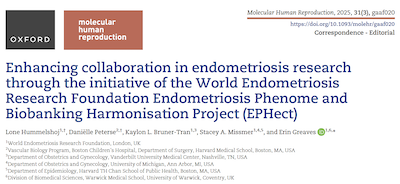
EPHect introduces standard operating procedures for the use of experimental models in endometriosis research
EPHect announces the publication today of four new research tools: standards for using different experimental models in endometriosis research.
Led by professors Kaylon Bruner-Tran and Erin Greaves, the work involves a collaboration of 44 international collaborators from 11 countries (representing five continents) and provides a comprehensive overview of the strengths and limitations of various in vivo and in vitro models that have been developed to study endometriosis1. These detailed standard operating procedures (SOPs) are designed to aid both new and established investigators.
The Endometriosis Phenome and Biobanking Harmonisation Project Experimental Models SOPs (EPHect-EM) have been published by Molecular Human Reproduction2-5 and comprise:

University of Warwick
Endometriosis research has long suffered from inconsistent reporting standards and methodological variability, making it difficult to compare findings or build cumulative knowledge. The EPHect experimental models’ framework build on previous EPHect tools and address this need by providing clear, consensus-driven SOPs and reporting tools.
By making these resources openly accessible, we’re not only improving reproducibility and rigour across the field, we are also increasing capacity by enabling new researchers to adopt best practices from the outset. This is a crucial step toward accelerating discovery and translating research into real improvements in diagnosis, treatment, and quality of life for those living with endometriosis.
said professor Greaves.
Professor Bruner-Tran added:

Vanderbilt University
Endometriosis is a complex disease that affects, or is affected by, numerous physiologic systems—including the endocrine, immune, reproductive, and nervous systems. Although endometriosis is often pigeon-holed as a reproductive disease, women with this condition are at an increased risk of developing cancer, central sensitisation, and digestive distress.
Unfortunately, the majority of current endometriosis researchers specialise in reproductive physiology. Thus, in addition to providing a framework to unify the efforts of current endometriosis investigators, a major goal of creating detailed experimental SOPs was to more readily enable seasoned investigators with expertise in other relevant fields to turn their attention to endometriosis.
Successfully tackling a multisystem disease such as endometriosis will take a multipronged approach that includes a wide range of scientific talent.
A summary of the SOPs can be read in the editorial published also today1.
EPHect
The Endometriosis Phenome and Biobanking Harmonisation Project (EPHect) is a collaboration among investigators in endometriosis research. By standardising the way in which clinical and surgical data is collected, and providing SOPs for collecting biospecimens, using experimental models, and how to conduct a physical examination, it is possible to compare data widely among research groups across the globe; and for these groups to collaborate. The EPHect tools are free to use and are available on the EPHect website.
Funding
Funding to develop this tool was provided by the World Endometriosis Research Foundation (WERF).
References
- Lone Hummelshoj, Daniëlle Peterse, Kaylon L Bruner-Tran, Stacey A Missmer, Erin Greaves. Enhancing collaboration in endometriosis research through the initiative of the World Endometriosis Research Foundation Endometriosis Phenome and Biobanking Harmonisation Project (EPHect). Mol Hum Reprod 2025;31(3):Epub.
- Katherine A Burns, Daniëlle Peterse, Caroline B Appleyard, Ronald Chandler, Sun-Wei Guo, Amelia Pearson, Eleonora Persoons, Michael S Anglesio, Michael S Rogers, Kathy L Sharpe-Timms, Joris Vriens, Stacey L McAllister, Kelsi N Dodds, Fiona L Cousins, Lone Hummelshoj, Stacey A Missmer, Kaylon L Bruner-Tran, Erin Greaves, for the EPHect Experimental Models Working Group. WERF Endometriosis Phenome and Biobanking Harmonisation Project for Experimental Models in Endometriosis Research (EPHect-EM-Homologous): homologous rodent models. Mol Hum Reprod 2025;31(3):Epub.
- M Louise Hull, Raul Gomez, Warren B Nothnick, Ruth Gruemmer, Katherine A Burns, Mohammed Zahied Johan, Isabella R Land, Stacey A Missmer, Lone Hummelshoj, Erin Greaves, Kaylon L Bruner-Tran, for the EPHect Experimental Models Working Group. WERF Endometriosis Phenome and Biobanking Harmonisation Project for Experimental Models in Endometriosis Research (EPHect-EM-Heterologous): heterologous rodent models. Mol Hum Reprod 2025;31(3):Epub.
- Kelsi N Dodds, Victor Fattori, Nick A Andrews, Caroline B Appleyard, Julie A Christianson, Raul Gomez, Stacy L McAllister, Stacey A Missmer, Jens Nagel, Paulina Nunez-Badinez, Michael S. Rogers, Philippa TK Saunders, Miguel A Tejada, Katy Vincent, Lone Hummelshoj, Kaylon L Bruner-Tran, Erin Greaves, for the EPHect Experimental Models Working Group. WERF Endometriosis Phenome and Biobanking Harmonisation Project for Experimental Models in Endometriosis Research (EPHect-EM-Pain): methods to assess pain behaviour in rodent models of endometriosis. Mol Hum Reprod 2025;31(3):Epub.
- Elizabeth E Marr, Juan S Gnecco, Stacey A Missmer, Shannon M Hawkins, Kevin G Osteen, Lone Hummelshoj, Erin Greaves, and Kaylon L Bruner-Tran, for the EPHect-Experimental Models Working Group. WERF Endometriosis Phenome and Biobanking Harmonisation Project for Experimental Models in Endometriosis Research (EPHect-EM-Organoids): endometrial organoids as an emerging technology for endometriosis research. Mol Hum Reprod 2025;31(3):Epub.
